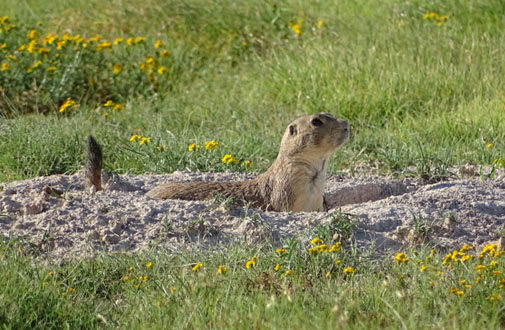Abstract
Currently, the geographic range of Cynomys mexicanus is restricted to the states of Coahuila, Nuevo Leon and San Luis Potosi, where there are active colonies of the species categorized as endangered, it´s stated that there is active colonies in Zacatecas. The objective of the study was to validate the presence of C. mexicanus in the historical distribution range in Zacatecas through literature review, geographic databases, consultation in ChatGPT® and field trips. The results showed translocations of the species in Tanque Nuevo with 98.30 ac, in Concepcion del Oro with 8.45 ac and Cienega de Rocamontes with 4.82 ac, all in Zacatecas. The first is isolated and an average of 65.73 ac from the active colonies of San Luis Potosi and more than 22.37 mi from Concepcion del Oro and Cienega de Rocamontes. The latter are separated by 0.78 mi and more than 37.28 mi from the San Luis Potosi active colonies. The Mojonera Protected Natural Area has more than 90 % of its surface in San Luis Potosi and the remainder in Zacatecas, the active colonies in the vicinity of the protected natural area were some of San Luis Potosi and not Zacatecas, that is, there was geographical confusion in the interpretation of the records of the studies found. The ChatGPT® query gave erroneous information, its information sources were 100 % false and the geographical locations given were more than 62.14 mi away from the translocations in Zacatecas.
References
Álvarez-Castañeda S.T., I. Castro-Arellano, T. Lacher y E. Vázquez. 2019. Cynomys mexicanus. The IUCN Red List of Threatened Species. <https://www.iucnredlist.org/species/6089/139607891>. [Consultado el 16 de octubre de 2023].
Biggins, E.D., J.G. Sidle, D.B. Seery y A.E. Ernst. 2006. Estimating the abundance of prairie dogs. Pp: 94-107, en: Conservation of the black-tailed praired dog saving north america’s western grasslands. (Hoogland J.L., ed.). Island Press. Washington, USA.
CONABIO. 2014. Localidades rurales y urbanas 1, 2010, escala: 1:1. COMISIÓN NACIONAL PARA EL CONOCIMIENTO Y USO DE LA BIODIVERSIDAD. México. <http://www.conabio.gob.mx/informacion/metadata/gis/loc2010gw.xml?_xsl=/db/metadata/xsl/fgdc_html.xsl&_indent=no>. [Consultado el 18 de octubre de 2023].
CONABIO. 2016. Cynomys mexicanus (perrito llanero mexicano) Registros de presencia usados para elaborar el mapa de distribución potencial. COMISIÓN NACIONAL PARA EL CONOCIMIENTO Y USO DE LA BIODIVERSIDAD. México. <http://www.conabio.gob.mx/informacion/gis/?vns=gis_root/biodiv/distpot/dpmamif/dpmrodent/cymx040rpgw>. [Consultado el 17 de octubre de 2023].
CONABIO. 2020. Cynomys mexicanus (perrito llanero mexicano) colonias activas. COMISIÓN NACIONAL PARA EL CONOCIMIENTO Y USO DE LA BIODIVERSIDAD. México. <http://www.conabio.gob.mx/informacion/gis/?vns=gis_root/biodiv/distpot/dpmamif/dpmrodent/cme005camgw>. [Consultado el 17 de octubre de 2023].
CONANP. 2014. Estudio previo justificativo para el establecimiento del área natural protegida de competencia de la federación bajo la categoría de Reserva de la Biosfera Desierto Semiárido de Zacatecas, ubicada en el estado de Zacatecas, México. COMISIÓN NACIONAL DE ÁREAS NATURALES PROTEGIDAS. México. <https://www.conanp.gob.mx/datos_abiertos/DGCD/2.pdf>. [Consultado el 16 de octubre de 2023].
CONANP. 2015. Programa de Manejo Área de Protección de Flora y Fauna Sierra La Mojonera. COMISIÓN NACIONAL DE ÁREAS NATURALES PROTEGIDAS. México. <https://simec.conanp.gob.mx/pdf_libro_pm/148_libro_pm.pdf>. [Consultado el 16 de octubre de 2023].
Elizalde-Arellano, C., Vargas-Miranda, B., López-Vidal, J. C., Rodríguez, C.Y.S. y L.D. García. 2022. Terrestrial vertebrates in the area of influence of the Sierra la Mojonera in San Luis Potosí and Zacatecas, Mexico. The Southwestern Naturalist, 65(3-4):237-248. DOI: 10.1894/0038-4909-65.3-4.237.
García-Peñalvo, F.J. 2023. The perception of Artificial Intelligence in educational contexts after the launch of ChatGPT: Disruption or Panic?. Education in the Knowledge Society, 24:1-9. DOI: 10.14201/eks.31279.
Garret, G.M. y L.W. Franklin. 1988. Behavioral ecology of dispersal in the black-tailed praired dog. Journal of Mammalogy, 64:236-256. DOI: 10.2307/1381375.
González, S.F.D. 2002. El perro de las praderas mexicano (Cynomys mexicanus Merriam, 1892) en el Noreste de México. Desarrollo de un modelo para la evaluación de su hábitat. SEMARNAT. Ciudad de México, México.
González-Uribe, D.U.; E. Estrada y C. Cantú. 2012. Análisis de fragmentación en colonias del perrito llanero mexicano (Cynomys mexicanus). Ciencia UANL, 15:1-7. <https://www.redalyc.org/pdf/402/40223164008.pdf>. [Consultado el 17 de octubre de 2023].
Gordijn, B. y H.T. Have. 2023. ChatGPT: evolution or revolution?. Medicine, Health Care and Philosophy, 26:1-2. DOI: 10.1007/s11019-023-10136-0.
Hoogland, J.L. 2006. Social behavior of prairie dogs. Pp. 7-26, en: Conservation of the black-tailed praired dog saving north america’s western grasslands. (Hoogland J.L., ed.). Island Press. Washington, USA.
Ibrahim, J. 2023. The art of asking ChatGPT for high-quality answers. A complete guide to prompt engineering techniques. Nzunda Technologies Limited. USA.
Kusch, J.M., Matzke, C.C. y J.E. Lane. 2020. Reproductive failure predicts intracolony dispersal of female black-tailed prairie dogs (Cynomys ludovicianus) in a northern population. Western North American Naturalist, 80:157-164. DOI: 10.3398/064.080.0203.
Matson, J.O. 1979. An analysis of rodent distribution patterns in Zacatecas, Mexico. Ph. D. Thesis. Michigan State University, East Lansing, Michigan.
Matson, J.O. y R.H. Baker. 1986. Mammals of Zacatecas. Special Publications. Texas Tech University. Museum, 24:1-88. DOI: 10.5962/bhl.title.156496.
Medellín L.R. y H.V. Bárcenas. 2021. Evaluación del estado de conservación y amenazas de Cynomys mexicanus en el marco del examen de revisión periódica de especies listadas en los Apéndices de la CITES. Universidad Nacional Autónoma de México. Instituto de Ecología. Informe final SNIB-CONABIO, Proyecto No. QE005 México. <http://www.conabio.gob.mx/institucion/proyectos/resultados/InfQE005.pdf>. [Consultado el 17 de octubre de 2023].
Pianka E.R. 1988. Evolutionary ecology. 4th Edition. Harper and Row. New York, USA.
Ríos-Muñoz, C.A., Espinosa-Martínez, D.V., Ballesteros-Barrera, C., Ameneyro-Cruz, G., López-Ortega, G., Arroyo-Cabrales, J. y L. León-Paniagua. 2017. Mamíferos de Zacatecas. Revista Mexicana de Mastozoología (nueva época), 7(1):1-24. DOI: 10.22201/IE.20074484E.2017.1.1.238.
SEDATU. 2014. Programa Regional de ordenamiento territorial del semidesierto que abarca los municipios de Concepción del Oro, Mazapil, Melchor Ocampo, El Salvador y Villa de Cos (Región Norte) del estado de Zacatecas. SECRETARÍA DE DESARROLLO AGRARIO, TERRITORIAL Y URBANO. El Colegio de México. <http://cit.zacatecas.gob.mx/documentos/PROT%20ECONOMIA/32PROT-NORTE%20%28semidesierto%29-COLMEX%2006-09-2016.pdf>. [Consultado el 16 de octubre de 2023].
SEMARNAT. 2018. Programa de Acción para la Conservación de las Especies Perrito Llanero de Cola Negra (Cynomys ludovicianus) y Perrito Llanero Mexicano (Cynomys mexicanus). SECRETARÍA DE MEDIO AMBIENTE Y RECURSOS NATURALES, Comisión Nacional de Áreas Naturales Protegidas. México. <https://www.gob.mx/cms/uploads/attachment/file/443951/PACE_Perrito_llanero_de_cola_negra.pdf>. [Consultado el 17 de octubre de 2023].
SEMARNAT. 2020. Unidades de Manejo para la Conservación de la Vida Silvestre (UMA). SECRETARÍA DE MEDIO AMBIENTE Y RECURSOS NATURALES. México. <https://gisviewer.semarnat.gob.mx/geointegrador2Beta/index.html>. [Consultado el 16 de octubre de 2023].
Treviño-Villarreal, J. y W. Grant. 1998. Geographic range of the endangered Mexican prairie dog (Cynomys mexicanus). Journal of Mammalogy, 79:1273-1287. DOI: 10.2307/1383019.
Truett, J.C., Dullum, J.A. L., Matchett, M.R., Owens, E. y D. Seery. 2001. Translocating prairie dogs: a review. Wildlife Society Bulletin, 29:863-872. DOI: 10.2307/3784413.
Valdés M., J. Pacheco, A. Betancourt, A. Marín, Y. Domínguez y G. Ceballos. 2023. Protocolo de monitoreo y manejo de los perritos llaneros (Cynomys ludovicianus y Cynomys mexicanus) de México. Universidad Nacional Autónoma de México. Laboratorio de Ecología y Conservación de Fauna Silvestre. Instituto de Ecología. México.
Zar, J.H. 1999. Biostatistical analysis. Prentice Hall. 4th Edition. New Jersey, USA.

This work is licensed under a Creative Commons Attribution-NonCommercial-NoDerivatives 4.0 International License.
Copyright (c) 2023 UNIVERSIDAD NACIONAL AUTÓNOMA DE MÉXICO




